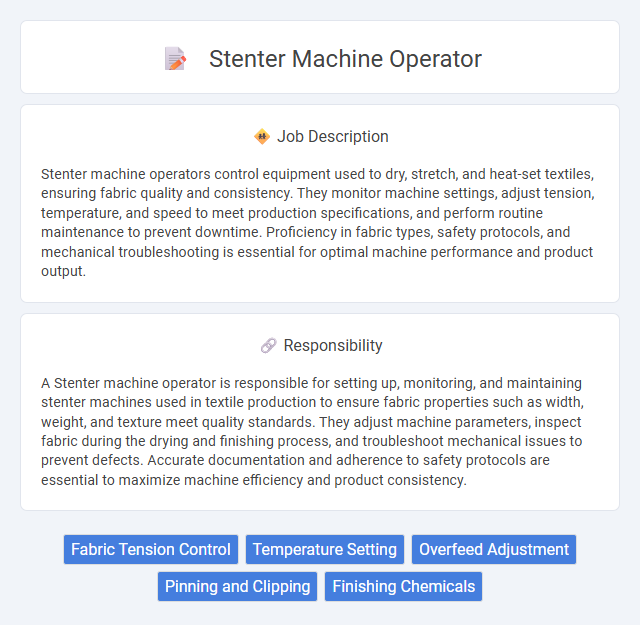
Stenter machine operators control equipment used to dry, stretch, and heat-set textiles, ensuring fabric quality and consistency. They monitor machine settings, adjust tension, temperature, and speed to meet production specifications, and perform routine maintenance to prevent downtime. Proficiency in fabric types, safety protocols, and mechanical troubleshooting is essential for optimal machine performance and product output.
People with good physical stamina and the ability to stand for long hours are probably well-suited for a Stenter machine operator job. Those who can maintain focus on monitoring machine operations and adjusting controls may find this role compatible with their skills. Individuals prone to fatigue or with limited attention spans might face challenges in consistently performing well in this position.
Qualification
A Stenter machine operator requires a high school diploma or equivalent, with specialized training in textile machinery operation preferred. Hands-on experience with fabric processing and knowledge of temperature control, fabric tension settings, and machine calibration are essential. Strong attention to detail and the ability to troubleshoot mechanical issues contribute significantly to job performance in textile finishing processes.
Responsibility
A Stenter machine operator is responsible for setting up, monitoring, and maintaining stenter machines used in textile production to ensure fabric properties such as width, weight, and texture meet quality standards. They adjust machine parameters, inspect fabric during the drying and finishing process, and troubleshoot mechanical issues to prevent defects. Accurate documentation and adherence to safety protocols are essential to maximize machine efficiency and product consistency.
Benefit
Operating a stenter machine likely offers significant benefits, including enhanced skill development in textile processing, which may increase job security and career advancement opportunities. The role probably provides exposure to advanced machinery, potentially improving technical expertise and employability. Steady employment in a manufacturing environment could also result in consistent income and possible access to benefits such as health insurance and retirement plans.
Challenge
The role of a stenter machine operator likely involves managing complex machinery that requires precise control to ensure fabric quality. Operators probably face challenges in maintaining consistent temperatures and tension settings to avoid defects during textile processing. The job may demand quick troubleshooting skills to handle unexpected machine malfunctions and minimize production downtime.
Career Advancement
A Stenter machine operator plays a crucial role in textile manufacturing by controlling fabric drying and heat-setting machines to ensure quality and consistency. Mastery of machine settings, troubleshooting, and fabric composition can lead to promotions, such as senior operator, supervisor, or quality control specialist roles. Developing technical skills and gaining experience with automated equipment opens pathways to career advancement in production management and process optimization within the textile industry.
Key Terms
Fabric Tension Control
A Stenter machine operator specializes in fabric tension control to ensure uniform fabric width and quality during drying and heat-setting processes. Precise adjustment of fabric tension prevents defects such as distortion, shrinkage, and uneven dye penetration, which are critical for high-quality textile production. Expertise in monitoring machine settings and fabric behavior enables operators to maintain optimal tension and improve overall fabric durability and appearance.
Temperature Setting
A Stenter machine operator is responsible for precise temperature setting to ensure fabric quality and consistency during the drying and heat-setting process. Optimal temperature control between 150degC and 220degC varies based on fabric type and desired finish, directly affecting shrinkage, texture, and color fixation. Mastery of temperature calibration improves production efficiency and reduces fabric defects, crucial for high-standard textile manufacturing.
Overfeed Adjustment
Precise overfeed adjustment in stenter machine operation is critical to fabric quality, controlling tension to prevent defects like shrinkage or uneven texture. Operators must calibrate overfeed settings based on fabric type, desired fabric dimensions, and machine speed to ensure optimal heat setting outcomes. Expertise in monitoring real-time fabric behavior during the drying and stretching process enhances productivity and minimizes material waste.
Pinning and Clipping
A Stenter machine operator specializes in controlling the pinning and clipping processes, ensuring fabric is stretched and fixed accurately for uniform width and shape. Expertise in adjusting pin bars and clip chains is vital to maintain fabric tension and prevent defects during drying and finishing. Precision in monitoring temperature and fabric movement enhances overall textile quality and production efficiency.
Finishing Chemicals
Stenter machine operators specialize in applying finishing chemicals to textiles, ensuring fabric quality and durability through precise control of temperature and tension during the drying process. Mastery in handling chemical formulations such as softeners, anti-pilling agents, and water repellents is essential for enhancing fabric properties and meeting industry standards. Expertise in monitoring chemical bath concentrations and timing directly impacts the efficiency and effectiveness of textile finishing operations.
 kuljobs.com
kuljobs.com